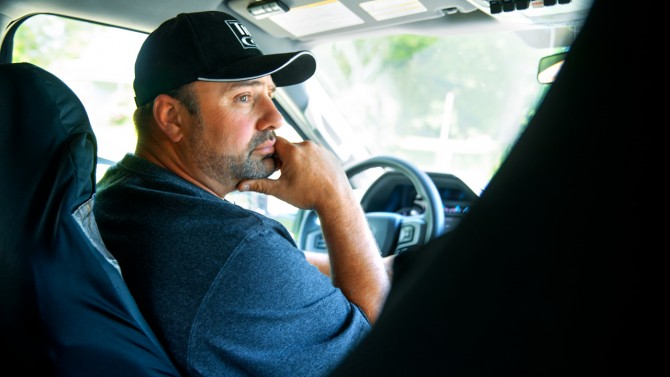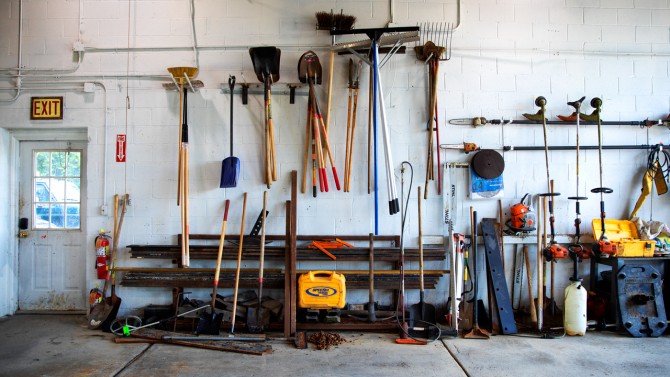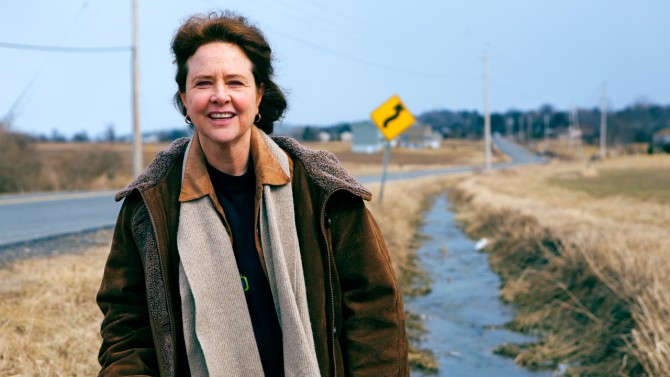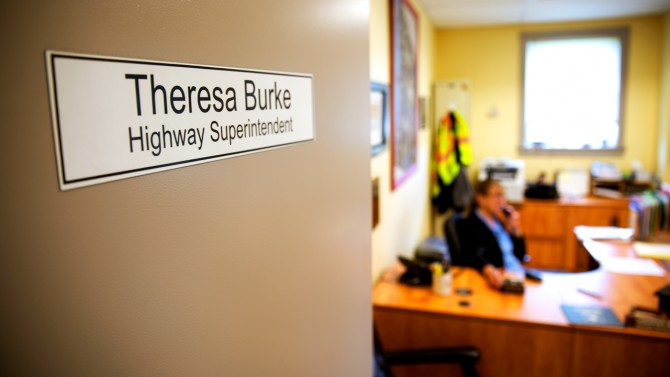Street smarts: Cornell paves the way for safer roads in NYS
By Susan Kelley
Chase Winton knew he had a problem.
A half-mile snippet of Albro Road, a sleepy byway in Sherburne, New York, 36 miles south of Utica, had severe cracks in its pavement. They made for a teeth-chattering ride.
“I don’t think you’d want to have an open coffee cup in your hand on that road,” said Winton, Sherburne’s highway superintendent.
It was his job to fix it.
Winton, a Sherburne native who went to school across the road from the town garage, drove his F350 pickup through the area’s rolling hills as he described Albro Road. Jutting up against the Chenango/Madison County line, it is home to a church and a handful of farms and houses at the northern edge of Sherburne, an agricultural town of 4,000 people.
Sheets of concrete underneath the road had broken apart at the seams, leaving a series of large rectangular cracks in the top layer of asphalt. Typical of the Northeast, water had been seeping into the crevices and freezing in the winter. Every year, the cracks grew wider. “It’s very hard to stop,” Winton said.
He worried the only solution was to start over. “I was thinking, jeez, what am I going to do?” Winton said. “I’ve got to tear that road all out, get all the concrete out of there, which is expensive.” That one repair would cost about $60,000, taking a 20% bite out of his $300,000 budget for road reconstruction.
This spring, Winton found a solution, through the Cornell Local Roads Program – which improves the quality and safety of New York’s local roads by offering free and low-cost services to the 1,500 village, town and county officials who maintain them. Its services range from project and financial planning software, called the Cornell Asset Management Program (CAMP), to “tailgate talks” on work site safety.
At a Local Roads workshop on pavement maintenance, Winton learned about a trademarked process called FiberMat. It smooths existing cracks and prevents new ones from forming. “The light bulb kind of came on,” he said. “I thought, ‘I have a place for that.’”
Chase Winton talks about how he has benefited from the Cornell Local Roads Program.
He hadn’t planned on working on Albro Road this summer, for lack of funds. “But after I went to the workshop, I thought maybe we can afford that,” he said. The repair will cost $13,000 and started in July. “It’s probably going to save us $40,000 in repairs to that road,” Winton said.
“As a good, responsible highway superintendent, you should probably consider using the resources that Cornell Local Roads provides.”
Chase Winton
Like Winton, thousands of highway officials have benefited from Local Roads since it was founded in 1951.
“Honestly, I think as a good, responsible highway superintendent, you should probably consider using the resources that Cornell Local Roads provides,” Winton said. “Hopefully in the end you can leave the entire road system better than you found it. That’s the goal.”
A mission to educate
The roots of the Cornell Local Roads Program date back to Feb. 15, 1915, when Cornell President Jacob Gould Schurman welcomed 280 highway officials to Cornell’s inaugural Good Roads Week.
“The state of New York is spending an enormous amount of money on a great system of highways,” Schurman said in his opening address. “Cornell University recognizes, as it has so often recognized in the past, that here is an industry based on science; here is a work in which the university might be helpful to the practitioner.”
Good Roads Week eventually grew into the current program, housed in Cornell’s Department of Biological and Environmental Engineering in the College of Agriculture and Life Sciences.
“The role of the highway official essentially is to keep those local roads in good shape – keep the farmer out of the mud, allow the bus to take kids to school safely,” said program director David Orr ’87, Ph.D. ’05, a licensed engineer and former deputy highway superintendent for Yates County. “Local Roads is helping them do that, with training, technical assistance, facilitating meetings – whatever method we need to use to help people help themselves.”
He and two staff engineers distill the latest scientific research from Cornell and such national sources as the Federal Highway Administration “into what folks on the ground need,” Orr said. They create training materials and lead 50 to 60 workshops per year in Cornell Cooperative Extension facilities and other locations throughout the state. Topics range from the latest money-saving pothole remedies to the best ways to quickly and safely move traffic through work zones. “If I can have each person take home one thing and change a habit, change a practice, try something out – I have had a good day,” Orr said.
He and his staff also field 600 to 700 questions by email and phone annually, from queries about the reflectivity of traffic signs to appropriate work zone clothing.
Theresa Burke, highway superintendent in Red Hook, an hour south of Albany, jokes that she’s worn out the coaster she keeps on her desk with the Local Roads phone number on it. “If you need to get in touch, they’re always available,” she said, “and so willing to help. They firmly believe in their mission to educate.”
Burke was one of more than 700 officials from across the state who attended the program’s 74th annual Highway School in June. It is the state’s largest highway operations training event, with workshops ranging from how to navigate legal issues to assessing infrastructure with drones.
More than 80 officials received pins for having attended for over 20 years. Keith Hurtgam, highway superintendent for Hartland, a town of 4,000 people near Lake Ontario, about an hour north of Buffalo, has attended for 34. “You learn something every time,” he said. “It’s just a wealth of knowledge. It’s here for our benefit.”
Keith Hurtgam, highway superintendent for Hartland, New York, describes the benefits of attending Cornell’s annual Highway School.
Creating a game plan
Sherburne’s Winton ran his own excavation company before he was elected highway superintendent in 2014. He was familiar with big equipment – but not with how to manage an entire road system.
“For me, coming into this new, it was a little bit overwhelming,” he said. “We have 64 miles of road, and it seemed like every mile needed something. So how do you prioritize? Where do you start?”
Through Local Roads, he found an answer: Cornell Asset Management Program (CAMP), a project planning software developed at Cornell. An intern – often a Cornell student – inventories a municipality's roads, assesses their condition and traffic volume, and inputs that data into the CAMP software. The highway superintendent adds the budget and the types of repairs the department does and the intern calculates the costs with the superintendent. The program then produces a detailed game plan, good for three to five years, outlining which roads to repair and how and when to do the work.
“The idea is to take your good roads and keep them good,” Winton said. “It may recommend you chip seal a road that looks perfectly fine, but based on the information collected, it probably needs a chip seal to keep it that way. Then for the roads that need complete reconstruction, it will defer until the funds are available.”
“The idea is to take your good roads and keep them good.”
Chase Winton
Unlike many Local Roads services, the CAMP program isn’t free; it costs municipalities $6,000 to $7,000, primarily to pay the intern, but, Winton said, “you save that the first year – just by not spending money on roads that you shouldn’t be spending money on. It’s a win-win.”
Local Roads helps highway officials go through the same decision-making process without the software. Thanks to that collaboration, Hurtgam, the Hartland superintendent, says his town has zero debt – thanks in large part to Hurtgam’s ability to keep the town’s highway costs down. And the roads are in their best condition ever.
“We used to use 600 tons of patching material. This year, we used three,” Hurtgam said. “It’s not about having all the money in the world. It’s about how you spend it.”
Research in action
Rebecca Schneider, Ph.D. ’94, has focused much of her 25-year academic career on something most people notice only if they drive into it: the roadside drainage ditch. As an associate professor of natural resources, Schneider wants to improve the quality and quantity of New York’s water. Two factors can make or break that proposition, she says: ditches and highway officials.
“We have inadvertently replumbed our entire watershed with ditches for over 100 years, without having any idea of their effect,” she said.
Deep ditches that are scraped clean of vegetation shunt tons of sediment, as well as road salt and pollutants directly into water supplies, her research shows. They also increase flooding, because they dump water into streams so quickly it can’t be absorbed. And they contribute to drought, she said. Her new message to highway officials: Don’t respond to the recent increase in torrential downpours by digging deeper ditches. They actually capture more runoff and subsurface flow, erode more quickly and need more maintenance.
To get the word out, she reached out to the Local Roads Program about 10 years ago. “I needed to get to the highway guys,” Schneider said. “They really are our water stewards across the landscape.”
Schneider is one of several Cornell researchers with whom Local Roads works to bring the latest research and techniques to highway officials. Thanks to her work, Orr said a few highway officials have started changing the way they manage their ditches.
“[Highway officials] really are our water stewards across the landscape.”
Rebecca Schneider
Winton is one of them.
Driving up Stone House Road, he pointed out a ditch his crew had minimally scraped and reseeded a few days earlier. Already new grass was preventing erosion, despite recent rain.
The minimalist strategy makes sense, Winton said. “Why are we doing all the extra work,” he said, “when we’re actually just making things worse?”
Getting the green light
Local Roads also helps officials navigate more complicated scenarios, like the one Red Hook’s Burke faced in 2016.
Burke, one of the few female highway superintendents in the state, had planned on paving Echo Valley Road, which winds through a residential development. “If I didn’t pave the road, it was going to fall apart and cost more money,” she said. “And there’s not a lot of money in the budget as it is.”
But local residents said they wanted her to narrow the road too, to slow cars they thought were speeding through the neighborhood. The town board asked Burke to postpone paving and conduct a study instead.
Theresa Burke, the highway superintendent for the town of Red Hook, New York, discusses how the Local Roads program helps her keep up to date with the latest best practices.
Orr offered her a model he had used for safety studies in other towns, and he mediated a meeting with residents and Dutchess County representatives. “Dave was very helpful,” she said. “He gave me some ideas of how to get this thing going.”
Through the study, she found narrowing the road would cost an extra $80,000, nearly doubling the cost of paving. And she discovered most cars weren’t actually speeding – there were just more of them because GPS navigation apps were directing drivers through the neighborhood.
Study results in hand, Burke presented to the town board her recommendations for basic paving and a traffic count. They gave her the green light.
“I feel Cornell continues to be an invaluable resource as things continue to change – budgets get tighter, new processes take the place of old processes,” she said. “They’re an unbiased source of information.
“It’s not your town board telling you. It’s not your residents telling you. It’s not your crew telling you,” Burke said. “It’s someone who has years of experience in the field giving you the answers and the guidance.”
New York State Impact
Street smarts: Cornell paves the way for safer roads in NYS
Media Contact
Get Cornell news delivered right to your inbox.
Subscribe







